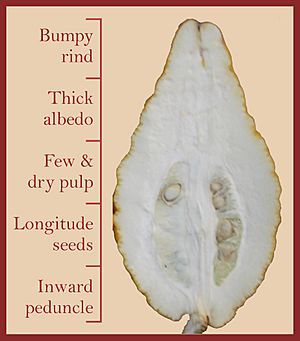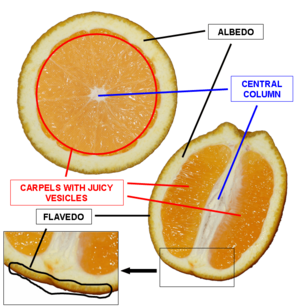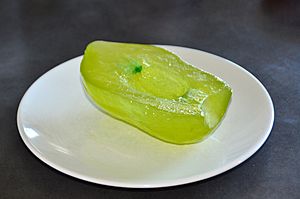Succade facts for kids

Diced succade
|
|
| Type | Confectionery |
|---|---|
| Main ingredients | Candied peel of citrus |
Succade is a sweet treat made from the candied peel of citrus fruits. It's often made from the citron fruit, which is a type of citrus with a very thick peel. The inside part of the citron peel isn't as bitter as other citrus peels, making it great for succade.
Sometimes, the word succade can also mean candied parts of other plants. This includes the peel, root, or even whole fruits and vegetables. Things like parsley, fennel, and cucurbita (like squash) can be boiled with sugar. This gives them a special sweet and sour taste.
Other fruits that are often candied include dates, cherries, pineapple, ginger, and even watermelon rind.
What's in a Name?
The word succade probably comes from the Latin word succidus. Some people think it might come from the Hebrew word sukkah. This is a temporary hut that Jewish people build for the holiday of Sukkot.
The citron fruit is called an etrog in Hebrew. It's one of the special Four Species used during Sukkot. After the holiday, some Jewish people candy the etrog or make marmalade from it.


In German, succade used to be called Succade. Today, it's usually known as Zitronat. In French, it's called fruit glacé or fruit confit. You might also hear it called candied fruit or crystallized fruit. People have been making this sweet treat since the 14th century.
How Succade is Made
Making succade from citrons is a careful process. First, the citron fruits are cut in half. Then, the inside pulp is removed. The peels are placed in seawater or salty water to ferment for about 40 days. The salty water is changed every two weeks.
After that, the peels are rinsed. They are then put into even saltier water in wooden barrels for storage or to be shipped. Before candying, the peels are partly desalted and boiled to make them soft.
Next, the softened peels are soaked in a strong sugar solution. This is called candying. The candied peel is then dried in the sun or stored in jars for later use.
Traditionally, candying was done in Livorno, Italy. They would get citrons from different places. These included Corsican citrons from Corsica, Diamante citrons from Liguria, Naples, Calabria, and Sicily. They also used Greek citrons from Greece through Trieste.
The fruit is soaked in sugar syrup over and over again. This makes the fruit full of sugar. The high sugar content stops tiny living things (like bacteria) from growing. This keeps the fruit from spoiling.
In some countries, like those in the Eastern Bloc, citrus fruits were hard to find. So, people made fake succade and candied orange peel. They used unripe tomatoes for succade and carrots for candied orange peel.
Ways to Use Succade
Succade is a popular ingredient in many baked goods. You might find it in cakes or as a filling for pound cake. It's also used in oliebol (a Dutch doughnut), plum pudding, florentines, and sfogliatelle.
It's a common ingredient in fruitcake or ontbijtkoek (a type of spiced cake). Succade is also added to raisin bread. It's often mixed with currants, raisins, cherries, and hazelnuts.
Sometimes, candied citron peel is covered in chocolate. People eat it as a sweet confectionery treat. Chopped succade is also used in cannoli, which are delicious Italian pastries.
Simple Recipes
Recipes for candied fruit can be different depending on the region. But the main idea is usually the same. First, you boil the fruit. Then, you soak it in sugar solutions that get stronger over several weeks. Finally, you dry out any extra water.
The high amount of sugar in finished candied fruits stops tiny germs from growing. This means candied fruits can last for many years without needing other ways to preserve them.
Fruits that are good for candying include cherries, plums, peaches, apricots, pears, starfruit, pineapple, apples, oranges, lemons, limes, and clementines. Angelica is a plant rarely used in Western cooking, except as a candied fruit.


